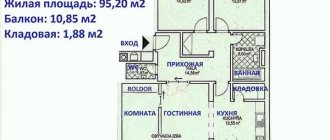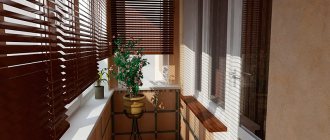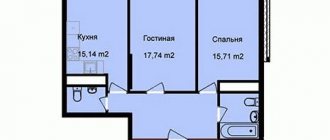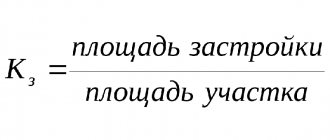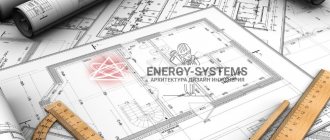Types of residential premises (Article 16 of the Housing Code of the Russian Federation, Article 673 of the Civil Code of the Russian Federation)
- Residential building or part of a residential building*.
- Apartment or part of an apartment.
- Living room**.
* This refers to a single-apartment residential building (see paragraph 2 of Article 673 of the Civil Code of the Russian Federation, as well as Chapter 6 of the Housing Code of the Russian Federation).
** Part of the room cannot be considered as an independent object of housing relations.
In accordance with Article 15 of the RF Housing Code, the total area of residential premises includes “the area of auxiliary premises intended to satisfy citizens’ household and other needs related to their residence in residential premises,” but does not include “balconies, loggias, verandas and terraces.”
Living room is a part of a residential building or apartment intended for use as a place of direct residence of citizens in a residential building or apartment (Article 15, paragraph 4 of the Housing Code of the Russian Federation).
Living area is the sum of the areas of all living rooms.
It is necessary to distinguish between a living room as a separate type of living space (i.e., can a citizen be registered there) and a living room as part of the living area of an apartment or house (which is taken into account when determining the living area).
Is the kitchen a living space or not?
I am very interested in the formulas for calculating ONE. Where According to the Decree of the Government of the Russian Federation dated 05/06/2011 No. 354, the formula does not include the area of the entire house or basements, basement, corridors, etc.... In Decree 354, the formula only includes the area of residential and non-residential (these are rooms + your non-residential premises ), this room is a dormitory, the calculation of ONE does not include the area of the basement, it also does not include corridors, kitchens with stoves, washrooms, etc., the formula is below and the explanation of the values: VD - the volume (quantity) of a utility resource consumed during the billing period in an apartment building, determined according to the readings of a collective (common building) utility meter. - the volume (quantity) of the utility resource consumed during the billing period in the u-th non-residential premises, determined in accordance with paragraph 43 of Rules No. 354; - volume (quantity) of a utility resource consumed during the billing period in the v-th residential premises (apartment), not equipped with an individual or common (apartment) metering device; - volume (quantity) of a utility resource consumed during the billing period in the w-th residential premises (apartment) equipped with an individual or shared (apartment) utility meter, determined by the readings of such a meter. In the cases provided for in paragraph 59 of Rules No. 354, to calculate the amount of payment for utility services, the volume (quantity) of a utility resource determined in accordance with the provisions of this paragraph is used; VIP - determined in accordance with paragraph 54 of Rules No. 354, the volume of the corresponding type of communal resource (electricity, gas) used during the billing period by the contractor in the production of utility services for heating and (or) hot water supply (in the absence of centralized heating and (or) hot water water supply), which in addition was also used by the contractor to provide consumers with utility services for electricity and (or) gas supply; >Si is the total area of the i-th residential premises (apartment) or non-residential premises in an apartment building; >S about - the total area of all residential premises (apartments) and non-residential premises in an apartment building.
According to their calculations
3916 (meter display)
*61.3 (non-residential area, mine):
1112.1 (living area)=
215 (they got ONE),
3916*61.3/1112.1=215
But the calculations do not take into account the area of corridors, basements, etc. The total area of the house is 2994.9, and the area of the basement is also not taken into account - 637.9.
If you calculate the entire volume of energy consumed for the entire area of the house and basement, then ONE turns out to be different.
2994.9+637.9=3632.8 (this is the area of the entire dorm and basement), and by the way, in the dorm rooms there are no meters, but I have them.
3916*61.3/3632.8=66 sq.t.
So much less.
Why, when calculating ALONE, do they not take that same area ALONE? After all, according to the formula that energy workers calculate, it’s not ONE they get, but the fact that I have to pay people for what they consumed in the rooms, but they already paid for it themselves? Why?
Which rooms are considered residential?
From the previous definitions it is clear that a living room is one that is intended for direct living. That is, the BTI employee taking measurements of the house will determine the living area in accordance with the names of the rooms that are indicated in the project or floor plan. Apparently the technique is as follows:
- All areas are measured.
- Areas that are not included in the total area (The area of an apartment in a residential building is defined as the sum of the areas of living rooms and utility rooms, excluding loggias, balconies, verandas, terraces and cold storage rooms, vestibules . - BTI Instruction, clause 3.36).
- The area of utility rooms is determined (Utility rooms include the area of kitchens, corridors, baths, toilets, built-in closets, storage rooms, as well as the area occupied by the apartment staircase - BTI Instruction, clause 3.36).
What premises do we still have:
- bedroom
- cabinet,
- restroom,
- dining room*
- living room.
* Please note that the “kitchen-dining room” will most likely be classified as a utility room (after all, it is a kitchen). If you really want to increase the share of living space, you can call it a dining room in the project, or even better, a living room, and to a fair question from a BTI engineer: “Where is your kitchen?” - say that you are going to make a summer kitchen outside. If I were a BTI employee, I wouldn’t believe it :).
The vestibule is clearly classified as premises that do not belong to the general area. The hallway is not on this list, but it is definitely taken into account in the total area when measuring the apartment.
If anyone has more accurate or newer information on this topic, please leave a comment.
comments 3
Help determine the area in a living space that must be taken into account when calculating the air exchange rate.
Greetings! What is the benefit of classifying the kitchen as a living space?
The Housing Code of the Russian Federation with commentaries, as well as federal laws and laws of the constituent entities of the Russian Federation can be found here: http: / / mosadvokat. org/ zhilishhnyj - kodeks - rf - s - kommentariyami /
Many citizens who are going to carry out any transaction with their real estate, or rather an apartment, are interested in the question of what is included in the living space of the apartment, because the more space allocated for living, the correspondingly higher the price of the property, this is quite normal. You should also know that the premises have not only residential, but also other types of areas. Everything that directly concerns the size of housing needs to be understood and understood, then you will be able to choose the most suitable housing.
Apartment zoning
In this material we will consider the main options for zoning apartments in relation to redevelopment projects. That is, in this case we are not interested in the aesthetic side of the issue - light, curtains, wallpaper and other ways of dividing rooms, which are important for designers, but in the functional division of the apartment into residential and non-residential areas, which during redevelopment can sometimes be combined or even swapped .
According to the Housing Code of the Russian Federation , changing the configuration of apartment premises is considered redevelopment. All changes to the original planning solution must be included in the technical passport of the BTI . In this case, the zoning of the apartment must be carried out in accordance with the current regulations for the approval of redevelopment and technical standards.
Zoning of living space in an apartment
The living space of the apartment can be reduced or, conversely, increased due to adjacent rooms.
Expanding the room at the expense of the kitchen area is not allowed by clause 24 of the Decree of the Government of the Russian Federation of January 28, 2006 No. 47, which states that it is not allowed to place the kitchen above the rooms of neighbors below. Since apartments in multi-storey buildings have identical vertical planning solutions, when expanding the room into the kitchen, the enlarged living space will end up under the kitchen area of the apartment from above, which will lead to a violation of the clause of this resolution.
Therefore, zoning the living space by expanding it into the kitchen is possible only in apartments on the top floors, above which no one lives, and provided that the non-load-bearing partition is demolished, an electric stove is installed in the kitchen, and there is no gas equipment in the house. It is forbidden to dismantle load-bearing walls, as well as to place a room above or below a kitchen with a gas stove. These rules also apply when remodeling with moving the kitchen and installing a living room in the vacated space.
Current sanitary standards do not allow the location of bathrooms and toilets directly above living rooms (clause 3.8. SanPiNa 2.1.2.2645-10 and clause 9.22 SP 54.13330.2016). For this reason, expanding a room with a toilet or bathroom in an apartment building is also possible only on the top floor.
But it is impossible to attach a balcony or loggia or part of their area to the room on any floor, since summer premises should be used only for their intended purpose, as required by the accepted rules and regulations for the technical operation of the housing stock. And in clause 10.19 of Appendix 1 to Decree No. 508-PP, this type of redevelopment is classified as prohibited. The only thing that current legislation allows is the replacement of the standard structure between rooms, consisting of a door, window and window sill, with French glazing, consisting of at least a double-glazed unit.
It is possible to “painlessly” expand the living space of an apartment due to the auxiliary/non-residential premises of the apartment. These include a corridor, storage room, hallway, dressing room, built-in closet. Only the already completed and legalized redevelopment of the neighbors living above can prevent such a redevelopment.
Extension of the room (1) onto the corridor (7) in the house of the P-44 series
If, for example, in an apartment on the floor above the kitchen or bathroom area was expanded onto the corridor, then the wet rooms will be above the corridor of the apartment below. And in this apartment, it will no longer be allowed to zone the room with the addition of part of the corridor space, above which the neighbor’s kitchen or bathroom is now located.
If the apartment has more than one living room, then it is possible to combine them or increase the area of one room at the expense of another. But the interior wall must be non-load-bearing, and both rooms after redevelopment must retain the natural light entering the living spaces from the windows in the front wall.
Zoning the kitchen in the apartment
The peculiarity of the kitchen from the point of view of zoning the apartment is that it cannot be expanded or moved into the living space, since according to the standards this worsens the living conditions of the neighbors below (clause 24 of the Decree of the Government of the Russian Federation of January 28, 2006 No. 47). The exception to this rule is apartments on the first and higher floors, under which there are no neighbors, but there is either a basement or a commercial premises (shop, cafe, etc.).
Also, it is forbidden to expand the kitchen into a bathroom. In this case, the upstairs neighbor’s bathroom will be above it, which is a deterioration of one’s own living conditions (clause 3.8. SanPiNa 2.1.2.2645-10 and clause 9.22 SP 54.13330.2016), which is prohibited. The exception to this rule is apartments on the top floors.
It is allowed to move the kitchen only to the non-residential area of the apartment. Only residents of the first floor can afford to coordinate the installation of a kitchen with an electric stove in place of the room. Therefore, most often the kitchen space is moved to the corridor - this redevelopment is allowed in apartments of any floors. In this case, you will get a niche kitchen . But a kitchen niche can only be equipped with an electric stove (clause 3.13 of SP 54.13330.2016). That is, it will not be possible to make a niche kitchen from a gasified kitchen, since this event is among the prohibited and therefore not compatible.
Installation of a kitchen niche (5) in the apartment
The zoning of one-room apartments is special. If a non-load-bearing partition is demolished between an electrified kitchen and a room, then care must be taken to ensure that exactly where the partition is located, a clear boundary of adjacent rooms is marked in the form of remaining pieces of the wall along the edges, some decorative elements, joints of different floor coverings, etc. Otherwise, the redevelopment will not be approved, since the living room attached to the kitchen will be considered non-residential. And an apartment must have at least one room, otherwise it cannot be recognized as a residential premises.
Combining a room (1) and a kitchen (2) with a gas stove in a one-room apartment with the installation of a sliding door block between them
Total area of the apartment - definition
This term refers to the total footage of all premises located in the housing, and it does not matter whether they are residential or utility.
These meters are used when calculating payments for utilities, in a sales contract, etc. It consists of:
- Rooms that are suitable for living in them.
- Children's room, living room and bedroom.
- A room reserved for cooking.
- Cabinets that are built into the wall.
- Niches located in the walls.
- Loggia.
- The corridor is also included in it.
- Terrace.
- Veranda.
Calculation of the total area of the apartment
This issue is worth understanding in as much detail as possible. After all, the price of the entire room depends on the total area, and it follows that it must be calculated correctly.
Everything is very simple, to find out what the estimated area of the entire apartment is, you should find out the footage of each room, and then sum up the resulting values . Determining the square meters of rooms is quite simple, using formulas familiar to everyone from a regular mathematics course at school. Please note that measurements are taken exclusively on the inside of the baseboard.
You may also find the formulas from the following article useful: how to calculate square meters (with examples). ⇐
Are partitions included in the total area of the apartment?
This is an important question that arises among people interested in calculating the total area of their home. The answer to this is found in the Housing Code and SNiP. It clearly states that they are part of the general living area.
Please note that the distance required to calculate the total area is measured along the perimeter of all walls at a height of 1.1 to 1.3 meters from the floor.
Living and total area of the apartment: what is included, how to determine and calculate
The laws specify what is included in the living and total area of an apartment. This information may be needed both when buying or selling, and for legal proceedings. Let's consider which rooms and other premises are considered residential in an apartment, what is included in the total area, what is excluded from it, and how to calculate everything correctly.
If you have any questions, you can chat for free with a lawyer at the bottom of the screen or call Free call for all of Russia.
Why is it important to know what area is considered living space in an apartment?
A detailed calculation of the residential, usable or total area of a residential premises may be needed in several cases:
- For litigation. For example, if the common property of the spouses is divided, the inheritance is disputed, the agreement on shared participation in construction is changed or terminated.
- To determine the cost of housing, taking into account the average price per square meter in the primary or secondary markets.
- To determine the tax base when calculating the property tax of an individual.
- To obtain housing under a social rental agreement.
- To calculate compensation for rental housing for military personnel.
- To process compensation and benefits.
Note: in the above situations, when determining living space, you need to focus on the norms of the Housing Code of the Russian Federation. In all other cases - according to the Federal Law dated December 30, 2009 No. 384-FZ “Technical Regulations...”, SP 54.13330.2016.
Take the survey and a lawyer will tell you for free how to avoid mistakes in an apartment purchase and sale transaction in your case
What does the living area of an apartment mean?
According to the law, a residential area is considered to be an area that includes all premises suitable for permanent residence:
- Bedroom.
- Cabinet.
- Hall.
- Children's room.
In fact, living space refers to rooms in which you can put a sofa or bed and relax. The kitchen, corridor, bathroom, etc. are not suitable for these purposes.
What applies to the total area of an apartment according to the Housing Code?
In Art. 15 of the Housing Code of the Russian Federation states that the total area includes all residential and auxiliary premises. The exception is balconies, loggias, verandas and terraces: they are not included in the total area.
For example, if a one-room apartment with an area of 40 sq.m. is purchased under the DDU, of which 3 sq.m. is a balcony, by law it is taken into account with a reduction factor of 0.3, and in reality the total area is 37.9 sq.m.
What is included in the usable area of the apartment?
By useful we mean the area of several rooms:
- Residential: rooms, bedrooms, living room, office.
- Auxiliary: bathroom, kitchen, balcony, etc.
Calculation with a reduction factor
The reduction factor is used to calculate the total area when purchasing housing under a shared construction agreement. It only applies to:
- Loggias – 0.5.
- Balconies – 0.3.
- Veranda – 1.0.
- Terraces – 0.3.
For example, if the area of residential and auxiliary premises is 50 sq.m., and the loggias are 5 sq.m., the total area of the apartment will be:
5 x 0.5 = 2.5 – taking into account the coefficient.
50 + 2.5 = 52.5 sq.m. – total area according to preschool building.
Are you planning a transaction for the purchase and sale of an apartment? Lawyers will answer any question regarding the transaction free of charge and in detail. Ask a question so you don't waste time reading!
What is included in the total area according to SNIP?
SNiP 02/31/2001 states that the total area includes all residential, auxiliary and outdoor premises. Including balconies, loggias, terraces, verandas. According to SNiP, storage rooms and mezzanines are also included in the total area, but this norm is used extremely rarely in calculations and legal proceedings.
Note! When determining the usable area, elevator shafts, ramps, and staircases are excluded.
How to determine the total area of an apartment?
You can calculate the total and living area by reading the layout. The footage of each room will be indicated there. All you have to do is write down the numbers and add them up.
Example:
Three bedroom apartment. The area of one room is 10, the second is 12, the third is 13 sq.m. Kitchen – 10 sq.m., bathroom – 6 sq.m., corridor – 8 sq.m.
The total is:
10 + 12 + 13 + 10 + 6 + 8 = 59 sq.m.
If there is no plan
You can calculate the living or total area yourself if you don’t have a plan on paper. To do this, just take a tape measure, a notebook or notepad, and a pen. If there are non-standard angles, you will need a protractor.
If the room is square or rectangular, you need to measure the length of two walls from one corner and multiply them. When unequal numbers are obtained, the two digits after the decimal point are rounded.
Legal advice: if the room is round or triangular, it is better to invite a specialist to do the calculations. Their area is calculated using separate formulas, and the calculation requires the most accurate measurements.
Do you need a sales contract? We’ll tell you how to draw up a contract correctly and avoid mistakes
Lawyer's answers to private questions
How to determine the living area of an apartment? It is enough to sum up the area of all residential premises: bedrooms, rooms, hall. Auxiliary premises are not included here. My husband and I are planning to divorce. We jointly own an apartment of 70 sq.m. with loggia 5 sq.m.
Will it be taken into account in the total quadrature during the division, or not? No, the area of the loggia is not taken into account when dividing. I will be selling my apartment soon. How should I indicate the total area in the ad: with or without a balcony? The general room is indicated without a balcony. Our house was declared unsafe.
They plan to allocate new apartments, the old one is 55 sq.m. How will their area be calculated? Must be given another apartment of at least 55 sq.m. If the area is larger, you will have to pay extra, but without taking into account the square footage of the balcony or loggia. I added a room to a private house. Naturally, the total area has increased.
What are my next steps? You need to issue a new technical passport from a cadastral engineer, and then make changes to the Unified State Register.
Expert opinion
Let's summarize:
- According to the Housing Code of the Russian Federation, the total area of an apartment includes residential and auxiliary (useful premises). Balconies, verandas, terraces, loggias are not taken into account. This rule is used for legal proceedings and in determining the value of real estate.
- According to SNIP, balconies and loggias are included in the total area, but these standards are important only for construction.
- If real estate is purchased under an equity participation agreement, a reduction factor is applied to the area of loggias or balconies. After this, the resulting amount is added to the remaining premises.
Source: https://SocPrav.ru/chto-vhodit-v-zhiluyu-i-obshhuyu-ploshhad-kvartiry
What is the living area of an apartment
Many people are interested in what exactly relates to the square footage of an apartment, for example, whether the kitchen is included in the living area of the apartment . The answer is simple - no. After all, by definition it is clear that residential means suitable for living. Even if the cooking room is equipped with everything necessary for sleeping, it is still not residential.
Hence the conclusion that the living area is the total square footage of all rooms suitable for living, for example, a bedroom, living room, children's room and other similar rooms. All other rooms, such as the kitchen, balcony, bathroom, etc., do not belong to the living space.
Residential
What is included in the living area of the apartment? First you have to find out what this term actually means. It is not difficult to guess that living space is the space in which people will live. In other words, premises suitable for habitation.
There doesn't seem to be anything difficult to understand. Only the population often cannot accurately answer what is included in a given area. After all, apartments have a different number of rooms, utility rooms, and even a bathroom. Is all this really included in our core component today? Not at all. But in order to fully understand what is included in each of the three existing areas, it is necessary to consider one more concept.
How is the living area of an apartment calculated?
There are several options for how to do this, for example, often the total area of your living space is already known. Then it is enough to calculate the footage of all premises that are not residential, and subtract the resulting result from the total area. But it may also be that the value of the entire footage of the apartment is unknown and there is no time to determine it.
You should calculate the area of each habitable room, and then add them up. The resulting value will be the living area of the apartment.
Is the kitchen, bathroom or toilet, balcony included in the living area
This has already been mentioned before, but it’s worth repeating just in case. All premises that are not suitable for living are not included in the living area of the apartment.
That is, it turns out that the kitchen, bath, toilet, balcony and similar rooms are not part of the living space of your house . Take this into account and exclude them when calculating, otherwise you will get the wrong footage!
Norms, rules and studio apartments
There are often options for two-room studio apartments on sale. Although the sellers themselves interpret this definition as “two-room apartments with a kitchen-studio”, in fact these are one-room apartments with a kitchen-living room. In fact, this is just an advertising gimmick that helps sell non-residential space under the guise of an additional room. The area of any type of kitchen is not included in the living area of the apartment and is not taken into account when defining a “studio”. The same applies to “studio apartments” with three or more rooms. SNiP also states that living rooms and the kitchen must have at least one source of natural light (window), that the common room (living room) in a two- or more-room apartment must be at least 16 square meters, and the area of the remaining rooms and kitchens - 8 or more square meters. So, in a two-room apartment, in addition to the kitchen, corridor, bathroom and rooms, there must be at least three windows - one window each for the rooms and the kitchen.
Please note => They didn’t make a note about the discharge in the house register, how can you understand that a person has checked out?
What does the square footage of an apartment affect?
First of all, it affects the cost of the apartment; the size of utility bills directly depends on the cubic capacity. For example, payment for heating is calculated taking into account the total area of the living space, excluding those rooms that are not heated. If there are no meters, payments for hot and cold water are calculated in the same way.
Not long ago, housing and communal services introduced “Common Household Needs”. They are also related to the square footage of the apartment. All homeowners pay TDS in relation to the area of the premises they own.
How to increase the area of an apartment
Many apartment owners do not agree with its layout, so they often want to make a renovation, that is, change the current arrangement of rooms, thereby making the living area larger or smaller. Before doing this, you need to obtain the appropriate permission:
- The citizen collects the necessary documents and submits them to the competent authority, which can be found at the location of the apartment.
- Consideration of the application can last 45 days from the date of its submission, then the owner will receive a response in writing.
- If the answer is positive, you can begin redevelopment.
Attention! If the answer is negative, it can be challenged in court. To do this, the citizen must submit an application, to which he must attach all documents confirming that the refusal is illegal.
List of documents that need to be submitted to the competent authority:
- Technical certificate.
- Inquiry as to whether construction work can be carried out.
- Ready redevelopment project.
- Documents confirming that the citizen is the owner of the property.
- Permission to carry out redevelopment from all co-owners.
- Technical expertise confirming that it is permissible to make changes to the current layout. Its results may prohibit doing this if the building of the house is, for example, dilapidated. This should be taken seriously.
Kitchen living room is a living or auxiliary area
Important. Designer fantasies will require the relocation of utility networks, electrical equipment and other communications: this is not always safe for the owner and neighboring apartments. The configuration of the premises is changing, and adjustments to the explication of the housing will be required. Therefore, redevelopments are approved by supervisory authorities.
From the previous definitions it is clear that a living room is one that is intended for direct living. That is, the BTI employee taking measurements of the house will determine the living area in accordance with the names of the rooms that are indicated in the project or floor plan. Apparently the technique is as follows:
What type of hostel is it?
According to Article 92 of the Housing Code of the Russian Federation, residential premises belong to a special type of housing stock. Issues regarding the transfer of non-residential premises to residential ones are regulated by state or municipal authorities. A hostel is a residential area in which you can live for many years . A person can also register in it.
Kitchen
The kitchen is considered to be a utility room. It is often equated to a balcony. It is used to prepare food, eat food and use it as a place to store food. An exception may be modern studio kitchens, which additionally play the role of a living room or bedroom.
Important! The main criterion for legal registration of non-residential premises is the lack of direct access to common areas.
This includes a toilet, corridor and other premises that are also considered non-residential. Thus, the kitchen is a non-residential object, but an auxiliary one .
Hotel
A hotel can act as a residential space that is unsuitable for permanent residence. It is important to pay attention to sanitary, fire and building regulations.
Often these objects are built separately, rather than being built on sites where people previously lived. An exception may be the basement floors. A hotel is considered a non-residential premises; permanent residence is not permitted .
Hostel
By law, a hostel is considered a hostel intended for temporary stay. He cannot occupy living rooms. To install it, you need to remove the apartments from the housing stock, after which a lot of mandatory and necessary operations must be performed.
Attention! Non-residential premises can be located on the ground floor. As for the second, it can be transferred to non-residential stock only if the first floor is already occupied. An additional mandatory requirement is the installation of a separate entrance adjacent to the entrance to the entrance.
In essence, these two points are responsible for the peace of the residents of the house, in addition, they guarantee the fact that the stairwells will be clean and comfortable.
According to the new law, you cannot place a hostel in a building that is not intended for housing . Often, too low rental prices attract people who are going to open hostels. But this often indicates that sanitary standards have been violated in the basements, and that some difficulties may arise in the process of arranging a new room.
The ground floor is considered suitable for temporary occupancy of people. It can accommodate showers, a kitchen or a gym. As for the basement, this cannot be done here. Following the above, a hostel is a non-residential premises.
Country house
A country house often acts as a premises in which one cannot live , despite the fact that according to documents it can be registered as residential. Often the building is not suitable for year-round living due to the lack of sewerage, heating and other necessary communications. If all this is present, then such a house is residential.
Apartments
Controversial are those apartments that, in accordance with the order of the ministry, designate a paid room for accommodating visitors. These are boarding houses, motels, hotels, sanatoriums and other places intended for temporary residence.
Apartments that have a bathroom and other communications are considered residential premises . And those in which it is not provided, you can install all the necessary systems in order to then register the property as a housing stock.
Minimum area of living rooms
In addition, there are requirements for the minimum width, length and height of living rooms in an apartment building. According to them, the minimum width of a living room should be at least 2.5 meters , while the recommended length is not specified, but by simple arithmetic it can be calculated that it should be at least 3.6 meters in order for the area to be those same nine squares. The height of the room must be at least 2.5 meters from floor to ceiling, which should be remembered when changing the floor design .
In addition to the requirements for the area of living rooms, there are also requirements for the area of auxiliary premises. For example, a kitchen must have an area of at least eight square meters, while for one-room apartments there are minimum requirements for a kitchen area of six square meters. Kitchen niches should occupy at least five “squares”.
Remodeling the kitchen and living room
If the apartment is one-room, then it will not be possible to combine the kitchen and an adjacent room to create a kitchen-living room. This is due to the fact that the kitchen is a non-residential space, and the room is a residential space, however, when they are combined, the entire resulting combined space belongs to the non-residential area. And according to current standards, an apartment must consist of a kitchen, a bathroom, auxiliary premises and a living room, i.e., we have no living space left in our apartment. Consequently, such a redevelopment cannot be agreed upon. Combining a kitchen and a room can only be considered if the number of rooms is 2 or more.
Sometimes owners decide to combine a loggia or balcony and a kitchen. Let us immediately note that this redevelopment will not receive approval, because the balcony is considered a summer unheated room and it is prohibited to connect it to the apartment, as this may disrupt the thermal contour of the building. You should not follow those who have unauthorizedly arranged such a redevelopment in their apartment - if discovered, it will create a lot of problems, including depriving the owner of the apartment of ownership rights to it.
Kitchen Living Room This Is A Living Or Utility Area
Muddy explanation of the term. Mitigating circumstance - taken from the Housing Code, i.e. invented by a government fool. There is no talk here about isolation or the fact that a room is a room. Consequently, it is possible to create many “parts of an apartment” (for example, for the “direct residence” of each member of a “clean Tajik family of 18 people”) in an apartment with one living space and legally call this apartment an 18-room apartment. The sneaky lawyer will prove this in court.
What does this have to do with municipal apartments? This is my own
apartment (let’s say mine personally is smaller). In it, in one room of 18 m2 of living space, 4 people “huddle”. The rest is auxiliary. I can prescribe at least a hundred and take it as a share. And it’s not just municipalities that are building apartments “for distribution”—a fresh example of black PR for the Russian Academy of Sciences. They will build a “two-room apartment with a total area of 500 m2” and provide this apartment to “the needy” - there are plenty of examples of this. And then he privatizes.
Is it possible to combine the kitchen and living room into a living space?
Life in a modern metropolis dictates new standards of comfort. If previously a large apartment had to have at least a kitchen, living room and bedroom, now for many this is by no means an axiom. Many people prefer a kitchen combined with a living room to a cramped kitchen and a spacious “living room” (with a traditional seating area, a large dining table, a sideboard and a TV).
— the general layout allows the hostess to cook without interrupting the general company of guests. As often happens, guests are in the house, and the hostess is always in the kitchen. The combined kitchen with the living room allows you to have fun chatting with friends and at the same time cutting salad, or you can invite someone to do it.
What is included in the living area of the apartment
But there is a legislative instruction that talks in more detail about the general space of the premises. It is characterized as the sum of the areas of all rooms in the apartment. Loggias, balconies, terraces, verandas are taken into account according to special coefficients - 0.5, 0.3, and 1, respectively.
To understand the difference between a residential zone and a general one, you need to understand what the area of the room as a whole is. It is usually called the totality of all rooms. It does not include rooms that are not heated. To find out the main differences between common and residential space, you should refer to the legislation.
Specific Ingredients
What is included in the living area of the apartment? It has already been said that these are suitable premises for living. They are the ones included here. In simple terms, this term refers to rooms.
It turns out that the more there are, the higher this indicator will be. Please note that the bathroom is not included in the living area. Why? It is not suitable for living. Therefore, it cannot be considered residential. This is a place you can’t do without, but no one will live in it.
Is the kitchen included in the living area of the apartment? No. It is not right. And this feature will also have to be taken into account. After all, sellers may try to increase the living space at the expense of the kitchen area, as well as balconies and bathrooms.
So what is included in the “living part” of the apartment? Rooms. The most ordinary rooms in which you will live. The more there are, the higher this indicator. Nothing else applies here. Not a single component of the apartment is included in the living space.
Chapter 1
Additional living space (above the norm) is provided to certain categories of citizens in the form of a room or in the amount of 10 square meters. m. For citizens suffering from severe forms of certain chronic diseases, as well as citizens who need this space due to the conditions and nature of the work performed, the size of additional living space can be increased. Categories of citizens and the size of additional space are determined in accordance with the resolutions and provisions of the Council of Ministers of the USSR, ministries and departments of the union republics.
Residential premises are provided within the limits of living space, but not less than the size determined by the Council of Ministers of the Ukrainian SSR and the Ukrainian Republican Council of Trade Unions. Residential premises may be provided in excess of the living space norm if it is one room (one-room apartment) or is intended for people of different sexes.
Is the kitchen considered living space?
Residential premises are provided within the limits of living space, but not less than the size determined by the Council of Ministers of the Ukrainian SSR and the Ukrainian Republican Council of Trade Unions. Residential premises may be provided in excess of the living space norm if it is one room (one-room apartment) or is intended for people of different sexes.
According to building codes and regulations (SNiP I-L.1-71 “Residential buildings”), only the area of living rooms is considered living area, and all other premises (built-in wardrobes, dressing rooms, bathrooms, kitchens, kitchen-dining rooms, etc. .) regardless of their area, relate to the usable (total) area and are not subject to payment.
We legalize the transfer of the kitchen to the living room: reasons
Kitchens in city apartments are far from perfect. The cramped space of 5-6 meters of old housing stock does not allow us to turn around at all. Sufficient in area, but geometrically elongated 10-11-meter buildings of new buildings limit functionality. Technologies allow you to move the kitchen into the living room. But how to legitimize the plan, and is such a step possible in principle?
- the housing area has been increased without changing the functional purpose;
- access to communications has been changed for the worse;
- the structural strength of the building is compromised;
- the loads on the structural elements are exceeded due to the use of heavier materials;
- a municipal apartment has been redesigned, as well as one not owned by a citizen.
What is included in the living area of the apartment? The concept of common and living space
Today we will try to understand what is included in the living area of the apartment. This question begins to interest citizens when they are about to carry out a real estate transaction. Namely, with an apartment. It is always important to know and understand how much space will be allocated “for living”. As practice shows, the higher this indicator, the higher the cost of housing. This is a completely normal phenomenon that should not be surprising. True, any apartment has not only living space, but also other types of areas. They also play their own role. All details regarding the size of the home must be understood. Only then will you be able to assess essentially how well the apartment suits your requirements.
To find out the above indicators in specific measurements for a specific apartment, you need to take an extract from the BTI. An apartment plan with detailed footage will be drawn there. Accordingly, the total area, both residential and non-residential, is indicated here. It is this document that affects the cost of housing.
Three components
What is included in the living area of the apartment? Before you begin to understand this issue, you need to get acquainted with all the “dimensions” of the home. It has already been said that there are several of them. At the moment, we can distinguish 3 components of the apartment:
- living space;
- apartment area;
- total area.
Without this knowledge, it is impossible to say exactly which apartment you are agreeing to. Therefore, real estate sellers are always asked for this information. If you know what is included in each type of housing area, you can not be afraid of being deceived in real estate transactions.
One-room apartment without partitions - non-residential premises
A residential building is recognized as an individually defined building, and an apartment is a structurally separate room in an apartment building, which consists of rooms, as well as premises for auxiliary use, intended to satisfy citizens’ household and other needs related to their residence in such a building or separate room.
As a result of combining the room and kitchen into one room, the newly formed room should be classified as auxiliary premises. The name of the newly formed premises must contain the word “kitchen”, for example: “kitchen”; "kitchen-dining room"; kitchen-living room”, etc.
Minimum kitchen niche area
20. It is not allowed to install a combined bathroom in two-room apartments of standard series houses, as well as in multi-room apartments if they do not have a second room equipped with a toilet. It should be noted that there are a series of five-story panel houses where a combined bathroom is designed in two-room and multi-room apartments. In this case, residents are not required to arrange a separate bathroom.
Coordination paths when arranging a new room will depend on whether you plan to affect floor structures. If this is planned, then the development of project documentation, that is, a redevelopment project, will be required. If the floor designs do not change, then the approval of the redevelopment will take place through a notification procedure or, as it is also called, approval according to the sketch.

